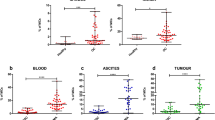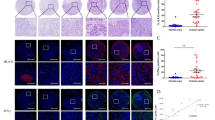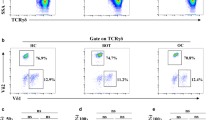Abstract
Inflammation has been implicated in the initiation and progression of ovarian cancer (OC), the underlying mechanisms of which are still unclear. We hypothesized that the abnormal expression of Toll-like receptors (TLRs), which were potential activators of nuclear factor-kappa B p65 (NF-κB p65), could promote inflammation and tumorigenesis in OC. In this study, we characterized the expression of TLRs in peripheral blood mononuclear cells (PBMCs) and found TLR2 and TLR6 mRNAs levels to be higher in PBMCs from OC patients than in those from benign disease (BC) or healthy normal controls (NC). Flow cytometry analysis showed that TLR1, TLR2 and TLR6 were highly expressed in monocytes from OC patients, but not in those from control subjects. Consistently, inflammatory cytokines interleukin (IL)-1β and IL-6 were up-regulated in PBMCs from OC patients upon stimulation with Pam3CSK4 (TLR1 ligand) and HKLM (TLR2 ligand), compared with unstimulated PBMCs. Stimulation of PBMCs with TLR ligands led to activation of downstream signaling molecules in TLRs (MyD88, TRAF6, TANK, NF-κB p65 and p-NF-κB p65). We also discovered that SK-OV-3-secreted factors were potent PBMCs activators, leading to the production of IL-1β, IL-6 and IL-8 through activation of TLRs and downstream signaling molecules in PBMCs. Before coculturing with SK-OV-3, pretreatment of THP-1 cells or PBMCs with monoclonal antibodies against TLR1, TLR2 or TLR6 inhibited the production of IL-1β and IL-6 and activation of MyD88, TRAF6, TANK, NF-κB p65 and p-NF-κB p65. Our results provided new evidence that TLR1, TLR2 and TLR6 signaling was linked with inflammation in OC microenvironment.





Similar content being viewed by others
Abbreviations
- BC:
-
Benign disease control
- EOC:
-
Epithelial ovarian cancer
- FBS:
-
Fetal bovine serum
- HRP:
-
Horseradish peroxidase
- IL:
-
Interleukin
- MyD88:
-
Myeloid differentiation factor 88
- NC:
-
Healthy normal controls
- NF-κB:
-
Nuclear factor-kappa B
- OC:
-
Ovarian cancer
- PAMPs:
-
Pathogen-associated molecular patterns
- PBMCs:
-
Peripheral blood mononuclear cells
- p-NF-κB:
-
Phospho-Nuclear factor-kappa B
- RT-PCR:
-
Real-time PCR
- TANK:
-
TRAF family member-associated NF-κB activator
- TLRs:
-
Toll-like receptors
- TNFα:
-
Tumor necrosis factorα
- TRAF6:
-
Tumor necrosis factor receptor-associated factor 6
- TRAIL:
-
TNF-related apoptosis-inducing ligand
References
Zhou M, McFarland-Mancini MM, Funk HM, Husseinzadeh N, Mounajjed T, Drew AF (2009) Toll-like receptor expression in normal ovary and ovarian tumors. Cancer Immunol Immunother 58:1375–1385
Beachy PA, Karhadkar SS, Berman DM (2004) Mending and malignancy. Nature 431:402
Balkwill F, Coussens LM (2004) Cancer—an inflammatory link. Nature 431:405–406
Mantovani A, Allavena P, Sica A, Balkwill F (2008) Cancer-related inflammation. Nature 454:436–444
Setia S, Nehru B, Sanyal SN (2014) Activation of NF-kappaB: bridging the gap between inflammation and cancer in colitis-mediated colon carcinogenesis. Biomed Pharmacother 68:119–128
Kim SS, Ruiz VE, Carroll JD, Moss SF (2011) Helicobacter pylori in the pathogenesis of gastric cancer and gastric lymphoma. Cancer Lett 305:228–238
Rehermann B (2013) Pathogenesis of chronic viral hepatitis: differential roles of T cells and NK cells. Nat Med 19:859–868
Zhang J, Li S, Yan Q, Chen X, Yang Y, Liu X, Wan X (2013) Interferon-beta Induced microRNA-129-5p down-regulates HPV-18 E6 and E7 viral gene expression by targeting SP1 in cervical cancer cells. PLoS One 8:e81366
Kaneda A, Matsusaka K, Aburatani H, Fukayama M (2012) Epstein–Barr virus infection as an epigenetic driver of tumorigenesis. Cancer Res 72:3445–3450
Giudice LC, Kao LC (2004) Endometriosis. Lancet 364:1789–1799
Costa NL, Valadares MC, Souza PPC, Mendonca EF, Oliveira JC, Silva TA, Batista AC (2013) Tumor-associated macrophages and the profile of inflammatory cytokines in oral squamous cell carcinoma. Oral Oncol 49:216–223
O’Neill LAJ, Golenbock D, Bowie AG (2013) The history of Toll-like receptors—redefining innate immunity. Nat Rev Immunol 13:453–460
Stender JD, Glass CK (2013) Epigenomic control of the innate immune response. Curr Opin Pharmacol 13:582–587
Sasai M, Yamamoto M (2013) Pathogen recognition receptors: ligands and signaling pathways by Toll-like receptors. Int Rev Immunol 32:116–133
Qian C, Cao X (2013) Regulation of Toll-like receptor signaling pathways in innate immune responses. Ann N Y Acad Sci 1283:67–74
Song DH, Lee JO (2012) Sensing of microbial molecular patterns by Toll-like receptors. Immunol Rev 250:216–229
Marusawa H, Jenkins BJ (2013) Inflammation and gastrointestinal cancer: an overview. Cancer Lett 345:153–156
Yu L, Wang L, Chen S (2013) Dual character of Toll-like receptor signaling: pro-tumorigenic effects and anti-tumor functions. Biochim Biophys Acta 1835:144–154
Kim S, Takahashi H, Lin WW, Descargues P, Grivennikov S, Kim Y, Luo JL, Karin M (2009) Carcinoma-produced factors activate myeloid cells through TLR2 to stimulate metastasis. Nature 457:102–106
Huang B, Zhao J, Shen SQ, Li HX, He KL, Shen GX, Mayer L, UnkelesS J, Li D, Yuan Y, Zhang GM, Xiong H, Feng ZH (2007) Listeria monocytogenes promotes tumor growth via tumor cell toll-like receptor 2 signaling. Cancer Res 67:4346–4352
He WG, Liu QY, Wang L, Chen W, Li N, Cao XT (2007) TLR4 signaling promotes immune escape of human lung cancer cells by inducing immunosuppressive cytokines and apoptosis resistance. Mol Immunol 44:2850–2859
Nakao Y, Funami K, Kikkawa S, Taniguchi M, Nishiguchi M, Fukumori Y, Seya T, Matsumoto M (2005) Surface-expressed TLR6 participates in the recognition of diacylated lipopeptide and peptidoglycan in human cells. J Immunol 174:1566–1573
Oliveira-Nascimento L, Massari P, Wetzler LM (2012) The role of TLR2 in infection and immunity. Front Immunol 3:79
Qiu Y, Ding Y, Zou L, Tan Z, Liu T, Fu X, Xu W (2013) Divergent roles of amino acid residues inside and outside the BB loop affect human Toll-like receptor (TLR)2/2, TLR2/1 and TLR2/6 responsiveness. PLoS One 8:e61508
Pinto A, Morello S, Sorrentino R (2011) Lung cancer and Toll-like receptors. Cancer Immunol Immunother 60:1211–1220
Bode C, Diedrich B, Muenster S, Hentschel V, Weisheit C, Rommelsheim K, Hoeft A, Meyer R, Boehm O, Knuefermann P, Baumgarten G (2014) Antibiotics regulate the immune response in both presence and absence of lipopolysaccharide through modulation of Toll-like receptors, cytokine production and phagocytosis in vitro. Int Immunopharmacol 18:27–34
Coussens LM, Werb Z (2002) Inflammation and cancer. Nature 420:860–867
Rakoff-Nahoum S, Medzhitov R (2009) Toll-like receptors and cancer. Nat Rev Cancer 9:57–63
Rhee SH, Im E, Pothoulakis C (2008) Toll-like receptor 5 engagement modulates tumor development and growth in a mouse xenograft model of human colon cancer. Gastroenterology 135:518–528
Cai Z, Sanchez A, Shi Z, Zhang T, Liu M, Zhang D (2011) Activation of Toll-like receptor 5 on breast cancer cells by flagellin suppresses cell proliferation and tumor growth. Cancer Res 71:2466–2475
Jeannin P, Duluc D, Delneste Y (2011) IL-6 and leukemia-inhibitory factor are involved in the generation of tumor-associated macrophage: regulation by IFN-gamma. Immunotherapy 3:23–26
Chow MT, Moller A, Smyth MJ (2012) Inflammation and immune surveillance in cancer. Semin Cancer Biol 22:23–32
Dinarello CA (2009) Immunological and inflammatory functions of the interleukin-1 family. Annu Rev Immunol 27:519–550
Dinarello CA (2011) A clinical perspective of IL-1 beta as the gatekeeper of inflammation. Eur J Immunol 41:1203–1217
Elkabets M, Ribeiro VSG, Dinarello CA, Ostrand-Rosenberg S, Di Santo JP, Apte RN, Vosshenrich CAJ (2010) IL-1 beta regulates a novel myeloid-derived suppressor cell subset that impairs NK cell development and function. Eur J Immunol 40:3347–3357
Bunt SK, Clements VK, Hanson EM, Sinha P, Ostrand-Rosenberg S (2009) Inflammation enhances myeloid-derived suppressor cell crosstalk by signaling through Toll-like receptor 4. J Leukoc Biol 85:996–1004
Nakao S, Kuwano T, Tsutsumi-Miyahara C, Ueda S, Kimura YN, Hamano S, Sonoda KH, Saijo Y, Nukiwa T, Strieter RM, Ishibashi T, Kuwano M, Ono M (2005) Infiltration of COX-2-expressing macrophages is a prerequisite for IL-1 beta-induced neovascularization and tumor growth. J Clin Invest 115:2979–2991
Voronov E, Carmi Y, Apte RN (2007) Role of IL-1-mediated inflammation in tumor angiogenesis. Adv Exp Med Biol 601:265–270
Song XP, Voronov E, Dvorkin T, Fima E, Cagnano E, Benharroch D, Shendler Y, Bjorkdahl O, Segal S, Dinarello CA, Apte RN (2003) Differential effects of IL-1 alpha and IL-1 beta on tumorigenicity patterns and invasiveness. J Immunol 171:6448–6456
Lane D, Matte I, Rancourt C, Piche A (2011) Prognostic significance of IL-6 and IL-8 ascites levels in ovarian cancer patients. BMC Cancer 11:210
Lo CW, Chen MW, Hsiao M, Wang SA, Chen CA, Hsiao SM, Chang JS, Lai TC, Rose-John S, Kuo ML, Wei LH (2011) IL-6 trans-signaling in formation and progression of malignant ascites in ovarian cancer. Cancer Res 71:424–434
Vicari AP, Caux C (2002) Chemokines in cancer. Cytokine Growth Factor Rev 13:143–154
Acknowledgments
We are grateful to the technical support from National Key Clinical Department of Laboratory Medicine of Jiangsu Province Hospital. This work was supported by National Natural Science Foundation of China (81272324, 81371894), Key Laboratory for Medicine of Jiangsu Province of China (No. XK201114), a project funded by the Priority Academic Program Development of Jiangsu Higher Education Institutions. The funders had no role in the study design, data collection and analysis, decision to publish or preparation of the manuscript.
Conflict of interest
The authors declare no financial or commercial conflict of interest.
Author information
Authors and Affiliations
Corresponding authors
Additional information
Xiaojie Zhang, Juan Xu and Xing Ke have contributed equally to this work.
Rights and permissions
About this article
Cite this article
Zhang, X., Xu, J., Ke, X. et al. Expression and function of Toll-like receptors in peripheral blood mononuclear cells from patients with ovarian cancer. Cancer Immunol Immunother 64, 275–286 (2015). https://doi.org/10.1007/s00262-014-1632-x
Received:
Accepted:
Published:
Issue Date:
DOI: https://doi.org/10.1007/s00262-014-1632-x




